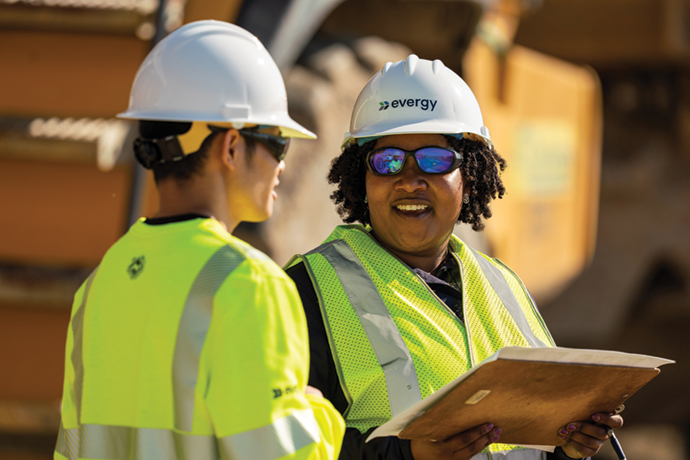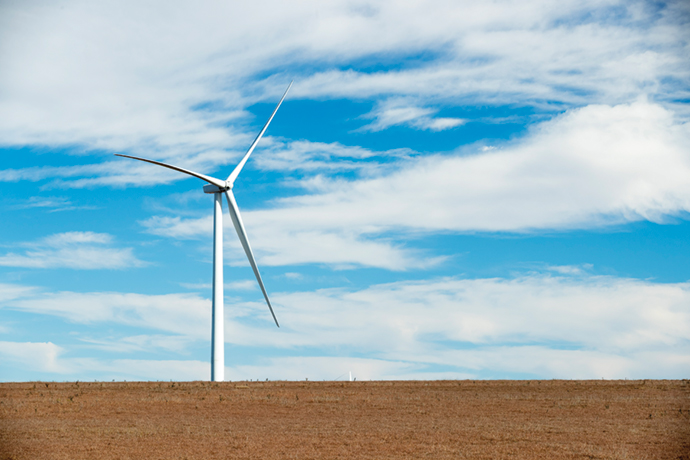When more than 50 businesses and organizations served by Kansas City–based utility Evergy begin receiving energy from two area wind farms in November as part of its Renewables Direct program that makes affordable, dedicated wind energy available to commercial customers, it was just one more sign of a virtuous circle involving economic development, power provision and a lighter carbon footprint.
“The expansion of wind energy in our area brings economic investment and jobs to communities near wind farms and affordable, clean energy to our customers,” said Terry Bassham, Evergy president and CEO. Power for those 50 customers is coming from NextEra Energy Resources’ Soldier Creek Wind Energy Center, a 300 megawatt wind farm in north central Kansas, and Ponderosa Wind Energy Center, a 200 megawatt wind farm in the Oklahoma panhandle.
“Renewables Direct is a great tool to attract new businesses to our area and to meet the needs of current customers using our area’s abundant wind energy. It helps customers realize their sustainability goals while providing long-term price stability,” said Jeff Martin, Evergy vice president of community and customer operations.
In 2019, wind fueled 41 percent of electricity production in Kansas, making it No. 2 nationally for wind energy as a share of total electricity generation. According to the American Wind Energy Association, development of wind farms in Kansas has brought more than $11 billion in capital investment and created more than 5,000 jobs in the state. Each year, project-related payments exceeding $60 million are paid to state and local governments and in lease payments.

Evergy, Inc., through its operating subsidiaries Kansas City Power & Light Company (KCP&L) and Westar Energy, Inc., provides energy to 1.6 million customers in Kansas and Missouri. In early 2020, Evergy announced with Kansas Governor Laura Kelly that it will expand its wind energy portfolio by 660 megawatts, and reduce carbon output by 80 percent below 2005 levels by 2050. Electricity from four new wind energy sites will be used to attract and retain large commercial and industrial customers. Combined, the four new wind projects (three of them in western Kansas) bring $180 million economic benefit to the region, including hundreds of construction jobs and dozens of permanent green energy jobs. They also bring great benefits to the communities through payments to landowners and to the tax base, and are funding school improvements among other projects in those communities.
Evergy is not the only utility getting into renewables. Kansas Electric Cooperatives (KEC) is the Kansas statewide service organization for 27 electric distribution cooperatives and three generation and transmission cooperatives. In November, 12 cooperatives announced the Kansas Cooperative Sun Power Program, a series of solar farms being developed by Today’s Power, Inc. (TPI)’s as part of a 25-year program that will result in attractive long-term prices and the construction of more than 20 MW of solar power at 21 sites spread out across more than 800 miles of the Sunflower State.
In August 2020, Evergy announced its Sustainability Transformation Plan (STP), a five-year strategic plan to deliver increased value for Evergy shareholders and benefit Evergy customers through additional cost reductions, improved grid reliability and security, enhanced customer experience and an accelerated transition to clean energy. Jeff Martin has been leading renewables program development for Evergy (and before the 2018 merger with KCP&L, for Westar) for a number of years. Now the direct renewables participation tariff is in place in every jurisdiction allowing companies such as Cargill, Textron, Spirit and Tony’s to subscribe directly with a wind farm and take the renewable energy credits as their own.
“From an economic development perspective, that is extremely attractive to a lot of companies already,” Martin says in an interview. “A lot of these companies are international and publicly traded, and their shareholders want them to be carbon-neutral. It’s green in two ways — it’s renewable, but we can give it to them cheaper in terms of their fuel cost.”
“More and more prospects have renewable requirements as part of their RFPs,” says Joe Fangman, Evergy’s senior director of economic development. If they do, says Martin, Evergy’s portfolio already is 50% carbon-free, “so if you have a customer who comes in looking for 50% renewable, we can sign the letter today.”
Battery storage is still in its infancy, but Martin notes that the new Evergy CEO David Campbell’s previous employer in Texas has one of the largest battery storage projects in the nation. “We’ll see more of that going forward,” Martin says, “along with additional solar and less fossil fuel power generation.”
Sustaining Business
Evergy last May committed $2.2 million to help agencies, communities and customers respond to and recover from the COVID-19 pandemic, bringing its 2020 planned community giving to more than $8 million. That includes the utility’s Hometown Economic Recovery Program, through which Evergy has awarded grants totaling $800,000 in such areas as small business needs, business attraction and retention, and workforce training and development.
Evergy’s economic development department helped to attract more than $335 million in corporate facility investment in 2019 to its territory, creating more than 3,460 jobs. Sustainability and sustaining the business community work hand in hand. Evergy’s team is one of only two utility economic development teams certified as an economic development organization by the International Economic Development Council.
“Our team partners with the communities as a unified force,” says Fangman, which facilitated the attraction of a number of investments in 2020, including Tony’s Pizza in Salina, Spirit Aerosystems and Cargill. “When communities win, we win.”

“In 2020 we got some legislation passed that increases the economic development incentives we can provide to attract bigger companies,” says Martin. “It matches legislation we have in Missouri. Now we can talk to customers regardless of which territory they’re looking at.”
They’re looking at Kansas a lot: 12 of the 16 projects the team worked in 2020 were on the Kansas side of the state line.
“When people ask about COVID-19 and project activity slowing, I tell them it’s been the opposite,” says Lisa Franklin, manager, economic development at Evergy. “We’ve had one of the best years ever. We have the right programs and legislation in place to be competitive. Kansas is doing a good job of landing the deals this year.”
Evergy’s programming also a program called SizeUP whereby small businesses can use a free-of-charge web platform to benchmark their operations as they consider expansion. The economic development team also offers individual investments to area leaders in such areas as business park master planning, labor studies, website development and drone work. “The investments we’ve made this year have been producing a lot of results,” says Franklin, “especially when doing site identification for business parks and master planning those parks,” including for projects in Salina and Leavenworth.
“There’s somewhat of a transformation in Kansas,” says Fangman, with more communities stepping forward with certified sites, for example. “We’re seeing good leadership from Kansas at the state level helping us have good success overall.”
“We are always aware that we don’t have beaches or mountains, but we have great infrastructure,” says Martin, “and programs to help companies meet their renewable goals.”

